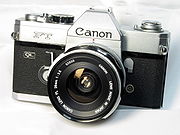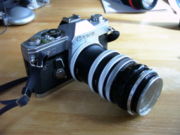
Canon FT QL
Encyclopedia



135 film
The term 135 was introduced by Kodak in 1934 as a designation for cartridge film wide, specifically for still photography. It quickly grew in popularity, surpassing 120 film by the late 1960s to become the most popular photographic film format...
single-lens reflex camera
Camera
A camera is a device that records and stores images. These images may be still photographs or moving images such as videos or movies. The term camera comes from the camera obscura , an early mechanism for projecting images...
introduced by Canon of Japan
Japan
Japan is an island nation in East Asia. Located in the Pacific Ocean, it lies to the east of the Sea of Japan, China, North Korea, South Korea and Russia, stretching from the Sea of Okhotsk in the north to the East China Sea and Taiwan in the south...
in March 1966. It has a Canon FL
Canon FL
Canon FL refers to a lens mount standard for 35mm single-lens reflex cameras from Canon. It was introduced in April 1964 with the Canon FX camera, replacing the previous Canon R mount. It was in turn replaced in 1971 by the Canon FD lens mount...
lens mount compatible with the large range of FL series lenses. The FT can also operate the later Canon FD series lenses in stop-down mode, but the earlier R series has a different lens aperture mechanism and cannot be used, although the bayonet fitting is similar. The standard kit lenses were Canon's 50mm f/1.8 ; 50mm f/1.4 and 58mm f/1.2, the body-only option was offered later.
FT QL was introduced in March 1966, a year after the pellicle mirrored
Pellicle mirror
right|thumb|The pellicle mirror of the [[Canon EOS RT]]A pellicle mirror is an ultra-thin, ultra-lightweight semi-transparent mirror employed in the light path of an optical instrument, splitting the light beam into two separate beams, both of reduced light intensity...
Canon Pellix
Canon Pellix
In the mid 1960s through the lens exposure metering was the new technology entering the SLR camera market. The Pellix was Canon's answer to that challenge. This technology was first successfully realised in a 35mm SLR camera in the remarkable Tokyo Kogaku KK Topcon RE-Super, launched in 1963, but...
. However it differs from the Pellix models, having a normal quick-return reflex mirror and offering stop-down TTL metering. The TTL metering is semi-spot in nature and works through a prism incorporated in the viewfinder condenser/screen assembly. The later Canon F-1 has a similar prism for metering in its removable screen. The Canon FT viewfinder screen is not user changeable. The pentaprism finder is fixed like the similar FX and FP models but unlike some earlier Canon R reflexes.
The cloth focal plane shutter has speeds from 1 sec to 1/1000 and B. The electronic flash sync. speed is 1/60. A delayed action timer gives 8 - 10 seconds delay, using the same front of body lever that actuates the stop-down metering. The mirror can be locked up for vibration reduction or for use with special FL lenses like the original 19mm f3.5 wide angle which projects deeply into the body and would foul the mirror.
The QL designation was a reference to Canon's ingenious and successful "quick load" system. A stainless steel sprung hinged device on the inside of the body rear door makes film loading easier than was normal at the time.
An accessory device, the Canon Booster, worked only with the FT QL. It is a plug-in device that sits on the accessory shoe and increases the metering sensitivity by a factor of 16 for measuring exposure in poor light. Its operation is somewhat clumsy and is best kept for tripod use.
The Canon FT is one of a series of three basically identical cameras released around this time. The first was the Canon FX which had a built-in meter, but not through-the-lens (TTL) metering, instead using a window on the camera body front. The next version was the FP which has no built-in meter and was the entry level camera. In the mid sixties there was still a good deal of suspicion of built in metering in some sectors of the photography community. The final model was the top of this sector, the FT QL. Canon needed to offer this variant to combat the growing popularity of the Pentax Spotmatic
Pentax Spotmatic
The Pentax Spotmatic is a range of 35mm single-lens reflex cameras manufactured by the Asahi Optical Co. Ltd., later known as Pentax Corporation, between 1964 and 1976. The original 1964 Spotmatic was one of the first SLRs to offer a through-the-lens exposure metering system, initially using...
variants as well as the Topcon
Topcon
Topcon is a Japanese manufacturer of optical equipment for ophthalmology and surveying. Their headquarters are in Itabashi, Tokyo. They are affiliated with Toshiba, which holds 40% of Topcon's stock.-History of Topcon:...
RE SLRs.
The FT QL and its sisters were an important step for Canon, leading to a number of improved versions such as the FTb and the full professional camera system the F-1. FT QL production ended in 1972 after the FTb was introduced.

